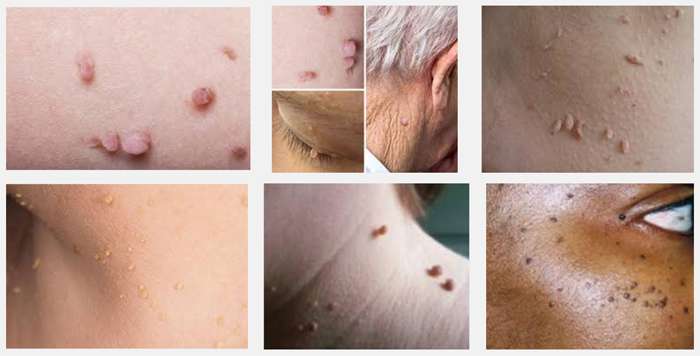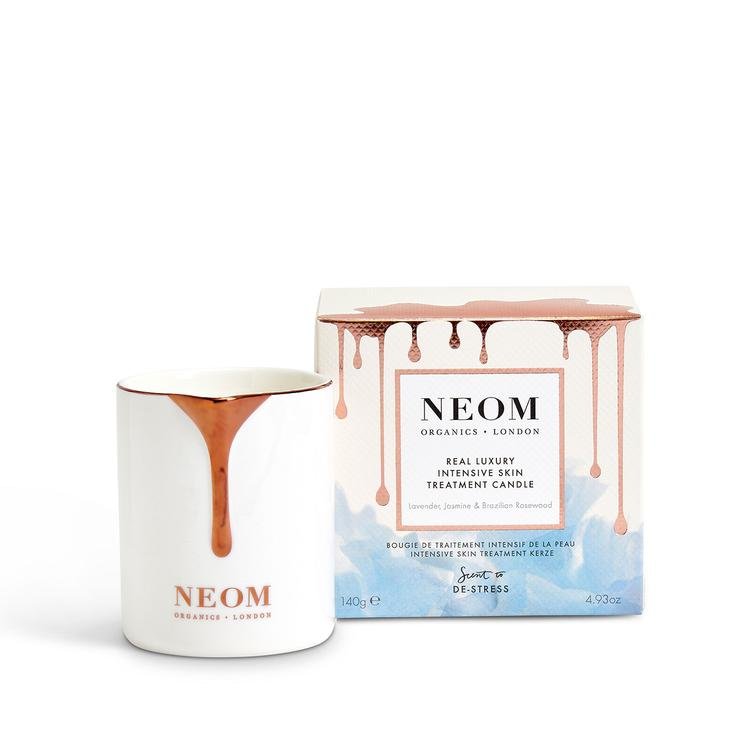
I’m not the only woman with Acrochordon. This is not wishful thinking. You probably do too. “What?’” you ask. Well, what if I called it skin tags? Ah, yes. Even if I didn’t know the prevalence of the strange-looking little things, I have had friends and acquaintances complain about them for years – and noticed them on many naked necks.
If you don’t have them, you still have something to look forward to. That is, if you consider cosmetic conditions to discuss with others “something to look forward to.” By the way, they escalate as we age.
Of course, everyone’s situation is different, so, be sure to check with your doctor about any abnormal skin features that you find on your body.
What Are Skin Tags?
These soft little (or not so little) balloons of flesh, with a stem, often called the “connecting stalk,” are considered ugly by many. I raise my hand in agreement.
But, while “acrochordon” is technically a name for a tumor (although benign), they are truly less of a concern to our health than to our confidence and vanity. Skin tags are considered harmless and are most annoying if they are rubbed by clothing or irritated by jewelry. One caveat is the act of shaving (men or women) – THAT can be painful if the skin tag is cut.
Sometimes a dermatologist or resource site will list a different type of skin tag known as Seborrheic keratosis. Why are they similar? As with a regular skin tag these growths are “extra skin” and look like a kind of brown scab stuck on the skin. They are also incredibly common, as we age. Since they are difficult to distinguish from a serious conditions it pays to get medical confirmation. Yet, they too are benign and perhaps even less annoying than balloon-like skin tags.
Home remedies (noted below) are also valuable for this type of growth, except the ‘hanging’ type since there is no noticeable “connecting stalk”.
Either type of skin tag is different from two other common dermatological skin “bumps:” lentigo and nevi (moles). Lentigines aren’t actually raised bumps, like moles. Instead they are brown spots with distinct outlines. They are often stimulated by the sun, and more commonly noticeable on pale skin.
Moles are clusters of cells (melanocytes which affect skin tone), usually raised and dark in color. “Moles” can be dangerous, as in melanoma, and that is the reason for the “A-B-C-D-E” guidelines (changes in asymmetry-border-color-diameter-elevation/evolution). Skin tags are the less worrisome and easier to handle cousins.

What Causes Skin Tags?
The problem with the skin tags is that they either dictate a trip to the dermatologist for a health scan, and/or extra money and procedures to get them removed.
Typical procedures include cryotherapy (freezing), ligation (cutting), laser (sometimes called Estheticon) or electrospray (a type of burning with electric current).
Many professionals will give a knee-jerk answer of “friction” when asked the question “what causes skin tags?” Surprisingly that answer may not be the only cause. A sole reason for the root of skin tags has not been medically confirmed. Friction is definitely part of it, but there are suggestions of hormone imbalance, obesity, genetics and skin irritation. There is also the idea that “low risk strains of Human Papilloma virus” (as in warts) may be a cause.
A study of reviewed literature found a significant level of the virus present in people with skin tags. I’ll go into a bit more detail later on how that may play into new over-the-counter treatments.
Oliver Cromwell on commissioning a portrait said: “Remark all these roughnesses, pimples, warts and everything as you see me, otherwise I will never pay a farthing for it.”
Ah yes, we might agree, sadly in real life we can’t “airbrush” ourselves!
My Own Story with Skin Tags
So, I found myself on a trip to visit a new dermatologist. Similar to meeting any new doctor, I wondered if she would promote some latest-and-greatest fancy treatment (read that as “expensive” and/or “invasive”). I hoped not.
In all honesty, I was most interested in a skin scan and not my skin tags. I assumed I had seborrheic keratosis, but needed to make sure. Luckily for me my scan was fine.
As an added bonus, the dermatologist was of the “natural” and “preventative” camp. She mentioned coconut oil as a potential solution to several skin and cosmetic issues. We are talking about topical applications here. Still, you can’t avoid hearing from the media about claims for many other advantages as well.
Could Coconut Oil Help You to Deal with Skin Tags?
For years, coconut oil was a bit demonized in the US because it is high in saturated fat. I was on that band-wagon. Indeed, coconut oil is high in saturated fats, perhaps one of the riches sources known. Check the label and you may see over 90% of the calories from the oil are saturated fats (or somewhere between 60-95%). So, if it is so high in saturated fats, why the change in recommending coconut oil for consumption purposes?
The answer is two-fold. Many large studies (including hundreds of thousands of participants) are apparently demonstrating that the process of how saturated fats affect cholesterol and arterial or heart disease is a bit of lore.
Some studies actually suggest that saturated fats raise HDL (the good) cholesterol – the type that works to transport cholesterol to the liver (and away from arteries) to be reused or eliminated. Similarly, other studies demonstrate that saturated fats change the bad LDL cholesterol to a less harmful type which one day may be shown to reduce heart and artery diseases.
Secondly, instead of the long-chain fatty acids found in most of our “traditional” (you might read that as “bad”) saturated foods, coconut oil consists of Medium Chain Triglycerides (MCTs). Compared to long-chain types, these fatty acids of medium length are metabolized (or digested) differently in the liver. The special properties of coconut oil reportedly aid in quite a number of health conditions and daily function.
But back to the coconut oil and skin tags. Before I describe the simple approach noted by my dermatologist, let me discuss two others. One I know works (but can hurt a little); the other sounds promising (but is more expensive).
Let me warn you that NONE of the three treatments mentioned here work quickly. So if you plan to be a do-it-yourselfer with such home remedies you have to be prepared to apply something else – patience. (Let’s say 6-8 weeks at a minimum). And, as always, you should check with your doctor before trying anything mentioned in this article.
Can You “Strangle” and Skin Tag?
If you are in your 50s or 60s, you probably know about this idea already as it is a certified “old fashioned remedy.” It’s not that simple to get right, but it works. We “hang” the skin tag by lifting it away from the skin and tying it tightly around the “connecting stalk” with dental floss or heavy-duty thread. It can be mildly uncomfortable.
You DO NOT immediately cut the tag off, as with true ligation. That would be outrageously painful. You knot the thread and leave it. The blood supply is slowly reduced. Ultimately the tag turns color (dark) and dries up.
Before two months you can almost rub it off with the lightest of pressure. You can protect against infection by keeping it clean, applying a topical antibiotic or covering with a plaster.
This hanging method has moments of tenderness or soreness but was not substantially painful the time I used it (a while back). Few people would want to do this in an area that is visible, like the neck, so that rules out a lot of tags. Again, it needs patience.
Over the Counter Skin Tag Removers
Personally, I cannot attest to whether over-the-counter (OTC) remedies work. However, do not let anyone laugh at you, if this is your choice. Products such as “Tag Away,” “Revitol Skin Tag Remover” or “Dermisil” contain a substance known as Thuja Occidentalis (an extract of northern white cedar).
There have been several double-blind studies showing its success for warts (and some other conditions like ring worm). If the theory is correct that the human papilloma virus is a primary cause of skin tags, the ability of this Thuja substance to stimulate the immune system may be a key as to why the OTC products are popular. Most tag treatments include Tea Tree Oil as well, which is said to help speed the drying process, but it is generally stinky, at least as a sole product.
Back to Our Discussion of Coconut Oil
My dermatologist recommends coconut oil for several skin issues, such as seborrheic keratosis. Typical skin tags (acrochordon) are also a condition that dermatologists include in this treatment category. Again, one of the theories is that the coconut oil decreases blood supply but does no harm to surrounding tissues. Applications are simple:
First cover the tag in coconut oil completely. Just a small amount will do it. Some people suggest covering the tag further with a Band-Aid or plaster.
Apply at least nightly; preferably day and night.
WAIT! (Patience, patience, patience.)
Coconut oil can be expensive, since most sources recommend the “organic virgin” types, but don’t forget that a little goes a long way.
Other sources say that these terms “organic” and “virgin” or “cold pressed” are not really industry standard as they are with olive oil. Coconut is the fruit of the coconut palm and it is the nut, or fruit, of the tree used to make medicine and quality oil.
Most sources say the preparation process matters, and that you should never use a liquid coconut oil for this application since one key element – lauric acid, with a strong effect on antimicrobial germs – is missing. I’m not certain of this claim, but I have only used the recommended varieties. Besides, they don’t seem any more expensive than the liquidized type.
There’s one additional positive aspect to using coconut oil. If it doesn’t work for your skin tags, you can check your cook books for a myriad of other uses. It will never go to waste!
Have you ever had a skin tag? What solutions or home remedies worked for you? Please join the conversation below.





